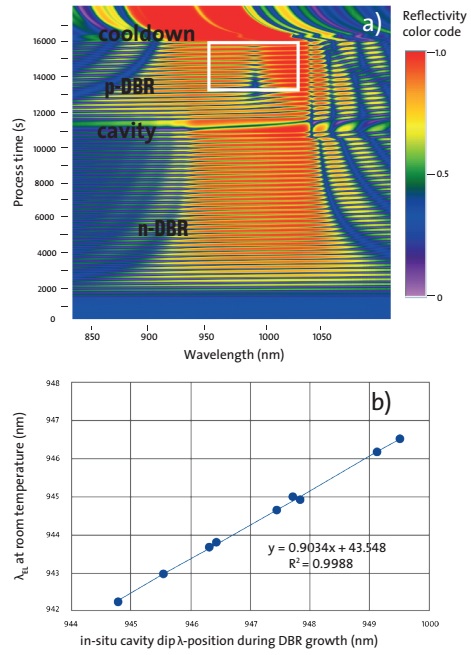- News
28 November 2019
LayTec develops algorithms for improved in-situ prediction of VCSEL emission wavelength
The target specifications for vertical-cavity surface-emitting laser (VCSEL) emission wavelengths currently lie within the ±0.5nm accuracy range. So, for yield prediction based on spectral in-situ sensing, an even better wavelength accuracy is needed, notes in-situ metrology system maker LayTec AG of Berlin, Germany.
The firm has hence recently developed advanced algorithms for dynamic cavity-dip analysis during p-DBR (distributed Bragg reflector) growth that take into account the specifics of wafer rotation in planetary reactors and apply advanced fitering and averaging procedures. The resulting ±0.2nm accuracy in in-situ measurement of high-temperature cavity-dip positions during the final periods of the p-DBR allows for highly precise prediction of the VCSEL emission wavelength, says LayTec.

Picture: (a) Reflectance color plot, as measured during epitaxy, for a 940nm VCSEL. The white square marks the in-situ cavity-dip region during p-DBR growth. (b) The correlation between the in-situ cavity-dip position and the room-temperature electro-luminescence (EL) emission wavelength.
In the Figure, part (a) gives an example in-situ reflectance color plot with the cavity-dip clearly visible during p-DBR growth. Part (b) shows more results from this VCSEL run: R2=0.999 correlation between the in-situ measured cavity-dip position during the final 10 periods of the p-DBR and the emission wavelength as measured by electro-luminescence (EL) at room temperature after the run. A deeper insight into the origin of the wavelength distribution can be gained by correlation of these high-accuracy cavity-dip positions with wafer temperatures and satellite numbers.


